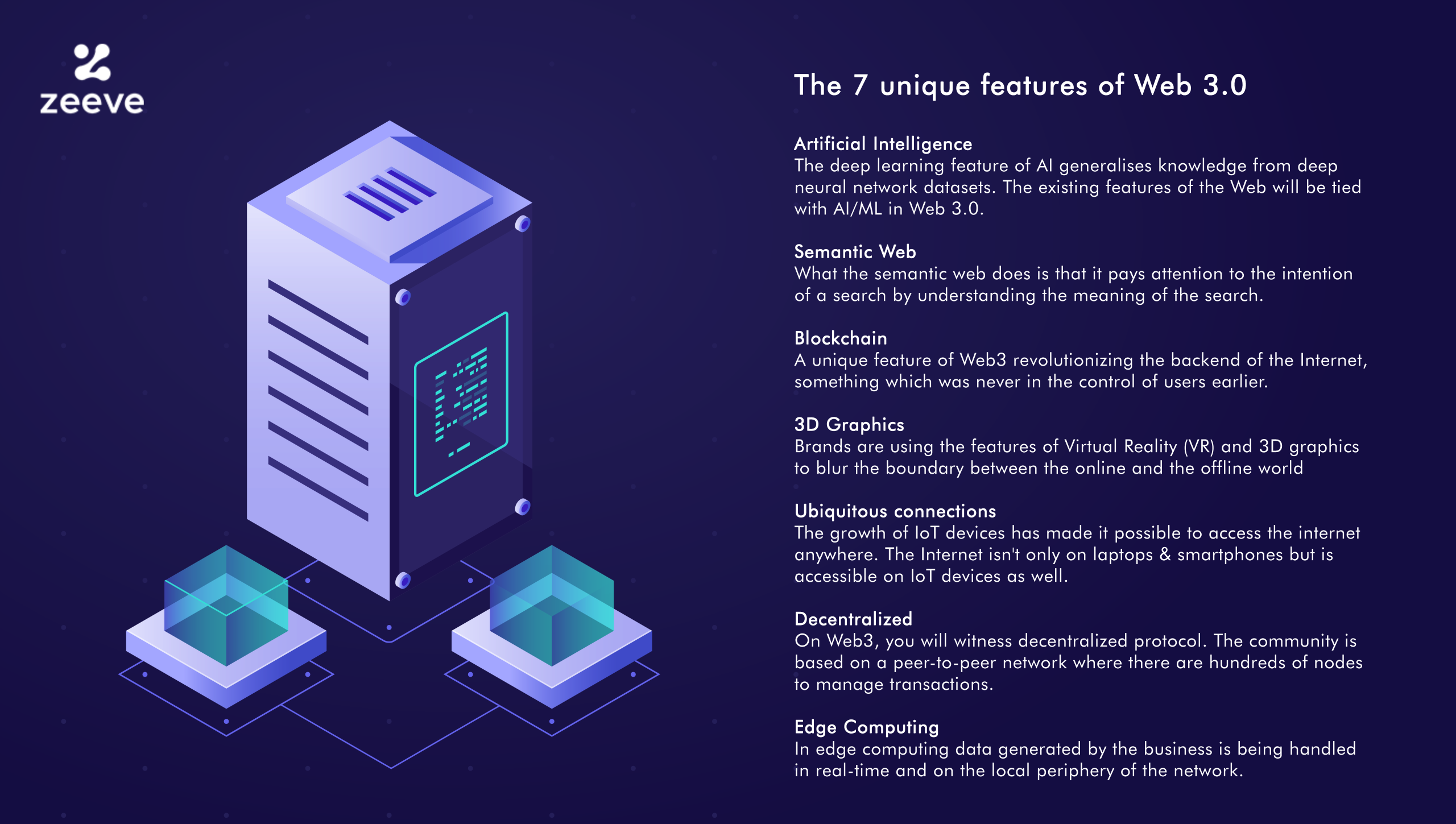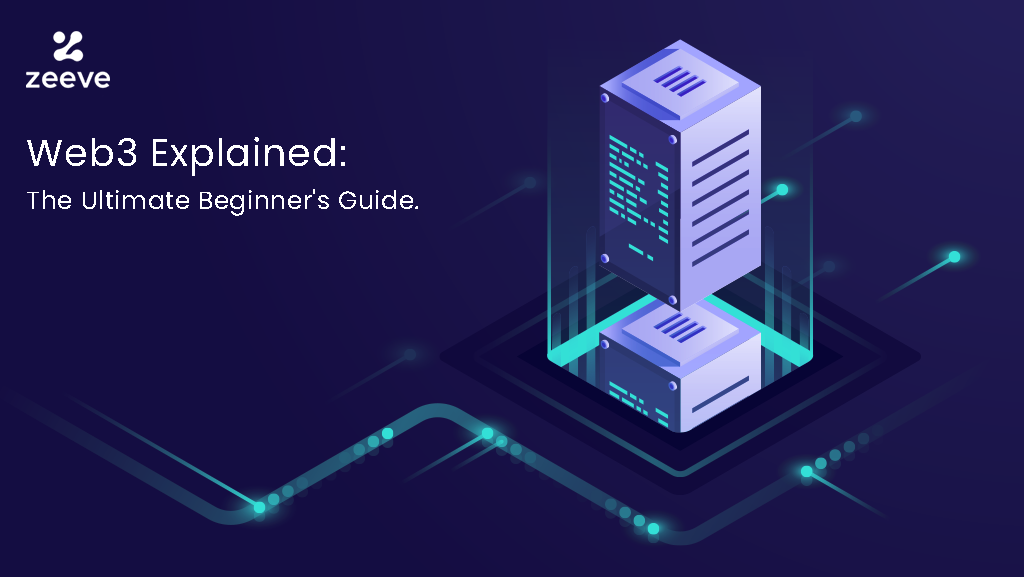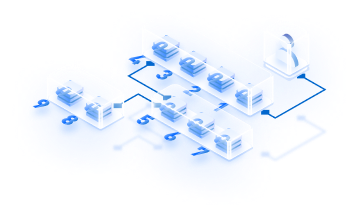There are billions of people who rely on the internet, whether for personal or professional purposes. The Internet enabled people who lived thousands of miles apart to communicate with one another. It aided education, healthcare, and business, among other things.
As per reports by Cisco, the consumer IP traffic has grown three times from 2017 to 2022, which is a lot! The mainstream adoption of Web 2.0 changed the perspective of marketing to selling for various products and services.
Yet, despite the popularity of Web 2.0 and various laws, the issue of data privacy still remains at the forefront. Now countries are acting together to strengthen the data privacy laws.
In the world of tech, developers and various organizations want to present a new version of the Internet to the masses, which is Web 3.0. To understand more about the emergence and the bright future of Web 3.0, keep reading till the end. In this blog, we will understand more about Web 3.0 and how it’s helpful for businesses.
Now let’s jump straight in!
Web 1.0 & Web 2.0
Web 1.0 was a read-only version of the Internet, also known as the syntactic web. There were a few people creating web pages and had a large group of readers.
Later, the read-write version of Web 2.0 emerged, which is what we are currently using. Web 2.0 supports interactivity and ease of use along with compatibility between the systems and the devices.
While community development was a more significant part of Web 2.0, Web 3.0 focuses on empowering individuals. However, the current system is heavily under the grip of large dominant internet firms like Google, Facebook, and a select few others.
Web 3.0
Thus, finally came Web 3.0. It is also known as the read-write-execute version of the Internet. The main aim of Web 3.0 is to provide excellent user utility along with anonymity.
The term Web 3.0 was coined by reporter John Markoff of The New York Times in 2006. It is a new evolution of the Web that incorporates specific innovations and practices. Below are seven main features that define Web 3.0:

7 Features of Web 3.0
Artificial Intelligence
AI is getting embedded in every software category, and unsurprisingly Web 3.0 isn’t away from it. The deep learning feature of AI generalizes knowledge from deep neural network datasets. The existing features of the Web, such as cyber-security, cloud computing, etc. will all be tied with AI/ML in Web 3.0.
Semantic Web
The current version of the Internet relies on keywords and numbers. What the semantic web does is that it pays attention to the intention of a search by understanding the meaning of the search. Further, the use of the semantic web will enhance the connectivity in Web 3.0.
Blockchain
A unique feature of Web 3.0 which has been doing the rounds since 2009 is blockchain. Moreover, the popularity escalated due to crypto. However, in reality, all applause goes to the Web 3 architecture. Blockchain technology is revolutionizing the backend of the Internet, something which was never in the control of users earlier.
3D Graphics
Brands are using the features of Virtual Reality (VR) and 3D graphics a lot nowadays. It’s one of the ways to blur the boundary between the online and the offline world. The feature is massively leveraged by real estate, gaming, e-commerce, and many more businesses.
Ubiquitous connections
“Ubiquitous” means which is present everywhere, and Web 3.0 is truly found everywhere. The growth of IoT devices has made it possible to access the internet anywhere. Now, the network isn’t only on laptops & smartphones but is accessible on IoT devices such as sensors and gadgets.
Decentralized
The driving technology behind the earlier versions of the Internet was Javascript, HTML, and CSS. However, here on Web 3.0, you will witness decentralized protocol. The community is based on a peer-to-peer network where there are hundreds of nodes to manage transactions.
Edge Computing
In edge computing, data generated by the business is being handled in the local periphery of the network. Through the use of edge architecture, companies can solve the issues related to unpredictable network disruptions and bandwidth limitations in real-time and close to the originating source of the problem.
What Web 3.0 offers
Ownership
The user owns every item on Web 3.0. The ownership comes in the form of NFTs. In addition, the currency is also decentralized, which is cryptocurrency. Cryptocurrencies can tokenize everything on the Web 3.0 internet. In short, tokens such as Bitcoin, ETH, Sol, and many more can be used for transactions. All the digital assets are being owned by the creators, something which isn’t possible in the present Web 2.0.
No Censorship
As creators or even business owners, we all want a certain level of freedom during any kind of content creation. As a creator on any social media, your work remains with the social media website; even if you leave the platform, the website will still own the creations.
For instance, a youtube creator has to adhere to the rules of youtube, whether it’s censorship or the income generated. However, on Web 3.0, the data exists on the blockchain network. You own the data and as a creator when leaving any platform there is a choice to plug into another interface along with your previous work.
Decentralized Autonomous Organizations (DAO)
Not only owning the data but even owning a platform on Web 3.0 is possible and this can be done by tokens. The tokens act as shares in a company.
DAOs eliminate the traditional VC and promote unique fundraising practices. The idea behind DAO is to present users with self-sovereignty and asset ownership by utilizing cryptocurrencies. You may have heard of Uniswap which is a decentralized exchange and is one of the examples of DAO in Web 3.0.
Limitations of Web 3.0
Web 3.0 is still a novel concept for many of the users. There are numerous advantages of the “future of the Internet” however, there are a few limitations as well, as discussed below:
User experience
Firstly, there are complex technical documentations with a lot of jargons. The user interface is dubious for a large number of people. The Web 3.0 infrastructure requires few changes so the general public can use it easily.
Awareness
Making the public aware of Web 3.0 can only be done by educating them. Similar to Web 1.0 and Web 2.0, it’s essential to make the information reach the audience that here we are in a new generation of web.
Accessibility
The accessibility is an issue because of the high transaction cost. To solve the problem layer 2 scaling solutions works. Layer 2 scaling solutions define when one network is divided into many small networks and operates on top of an underlying blockchain network. For example, Bitcoin is a Layer-1 network while Lightning is Layer-2, built on Layer-1 Bitcoin.
What do the stats say about Web 3.0 for Enterprises?
As reported by Pitchbook, the investment in Web 3 startups has reached $23.7 billion.
Web 3.0 will not take over Web 2.0 by the end of the decade. Still, enterprises need to start understanding the technology.
Recent studies show that around 43% of the people want to become early adopters of Web 3.0. This largely applies to businesses so as to establish themselves as industry leaders.
What Web 3.0 offers to Enterprises?
With the advent of blockchain, we are witnessing the decentralization & tamper-proof information presented to the consumers. The trust between businesses and consumers will improve further in the future.
Real-time tracking of information will enhance the working of an organization. At every stage of a production process, information will be visible to the consumers. Here are a few of the features of Web 3.0 that are compatible with enterprises:
- Better regulation compliance: As the record of transactions of a business is available to everyone on the chain. Companies are able to maintain transparency along with governance.
- Supply chain management: Supply management has always been difficult for companies. But with Web 3.0, supply chain management is becoming trouble-free day by day. The Web 3.0 improves time management for any business by eliminating silos of information.
- Enhanced Security: Along with better supply chain management and better customer trust. Due to a tamper-proof system, there isn’t a single point of failure. With Web 3.0, data breaches occur less frequently.
- Integrated Transparency: With better customer participation and proper regulation of the feedback. Enterprises can expect transparency between both the clients and the customers.
- Unique Marketing: As artificial intelligence plays a crucial role in Web 3.0 data evaluation becomes easy. Therefore the marketing of an enterprise is strengthened. Reaching out to target customers can be done more effectively.
- Improved Automation: Now businesses can save hours of time as automation is easier in Web 3.0. Companies can use automation from managing sales processes to sending personalized messages at a click.
- Power to End User: Lastly, as decentralization is one of the core features of Web 3 the end users or the customers will have control over their data. This will improve the trust of the company among the consumers.
How to incorporate Web 3.0?
Till now, you must have understood all the unique features of Web 3.0. Furthermore, to stay ahead of the curve, every business organization and individual will have to keep educating themselves. You can do this by monitoring the technological developments of Web 3.0.
Businesses can invest in smart contracts and blockchain technology to become aware of the ongoing developments. As blockchain already benefits businesses in multiple ways, employing it more in existing infrastructures is essential.
Wrapping Up!
Due to its decentralization feature, Web 3.0 apps do not require any data centers or expensive servers. The end-user is the leader here thus, there are massive chances of Web 3.0 adoption en masse.
We are on the verge of seeing the most economic-driven and personalized version of the web. From fuelling the creator’s economy to streamlining business processes, it’s time to harness the power to its full potential.
The creation of Web3.0 is to empower individuals. As Web 2.0 did attract users on the internet. However, there were a lot of data breaches on the current version of the internet. Thus to counter the problems of the existing network Web 3.0 is here. From Semantic Web to Edge Computing there is so much that Web 3.0 presents to everyone. With decentralization at its core, Web 3.0 will bring security, transparency, and better regulation compliance to the enterprises and creators. The onset of Web3.0 has also supercharged the creator’s economy. There are certain limitations of Web 3.0 as well, as the awareness is still not much in the public domain. We are on the verge of seeing the most economic-driven and personalized version of the web. From fuelling the creator’s economy to streamlining business processes, it’s time to harness the power to its full potential.
Partner with Zeeve
Your organization will undoubtedly benefit from the immense features of Web 3.0. Are you still wondering how you will deploy Web 3.0 Infrastructure? We at Zeeve are here to help you.
Zeeve is the leading Web 3.0 and Blockchain Infrastructure Management platform trusted by thousands of Blockchain Startups, Enterprises, and Web 3.0 Developers. To learn more about Zeeve, feel free to connect with us on Twitter and Telegram.





